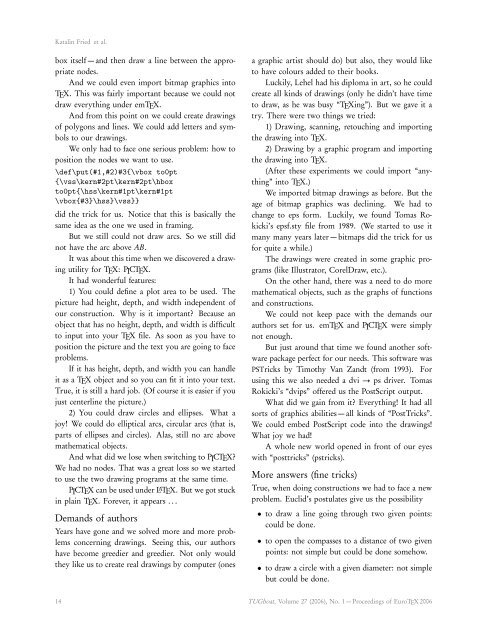The Communications of the TEX Users Group Volume 27 ... - TUG
The Communications of the TEX Users Group Volume 27 ... - TUG
The Communications of the TEX Users Group Volume 27 ... - TUG
Create successful ePaper yourself
Turn your PDF publications into a flip-book with our unique Google optimized e-Paper software.
Katalin Fried et al.<br />
box itself — and <strong>the</strong>n draw a line between <strong>the</strong> appropriate<br />
nodes.<br />
And we could even import bitmap graphics into<br />
<strong>TEX</strong>. This was fairly important because we could not<br />
draw everything under em<strong>TEX</strong>.<br />
And from this point on we could create drawings<br />
<strong>of</strong> polygons and lines. We could add letters and symbols<br />
to our drawings.<br />
We only had to face one serious problem: how to<br />
position <strong>the</strong> nodes we want to use.<br />
\def\put(#1,#2)#3{\vbox to0pt<br />
{\vss\kern#2pt\kern#2pt\hbox<br />
to0pt{\hss\kern#1pt\kern#1pt<br />
\vbox{#3}\hss}\vss}}<br />
did <strong>the</strong> trick for us. Notice that this is basically <strong>the</strong><br />
same idea as <strong>the</strong> one we used in framing.<br />
But we still could not draw arcs. So we still did<br />
not have <strong>the</strong> arc above AB.<br />
It was about this time when we discovered a drawing<br />
utility for <strong>TEX</strong>: PIC<strong>TEX</strong>.<br />
It had wonderful features:<br />
1) You could define a plot area to be used. <strong>The</strong><br />
picture had height, depth, and width independent <strong>of</strong><br />
our construction. Why is it important? Because an<br />
object that has no height, depth, and width is difficult<br />
to input into your <strong>TEX</strong> file. As soon as you have to<br />
position <strong>the</strong> picture and <strong>the</strong> text you are going to face<br />
problems.<br />
If it has height, depth, and width you can handle<br />
it as a <strong>TEX</strong> object and so you can fit it into your text.<br />
True, it is still a hard job. (Of course it is easier if you<br />
just centerline <strong>the</strong> picture.)<br />
2) You could draw circles and ellipses. What a<br />
joy! We could do elliptical arcs, circular arcs (that is,<br />
parts <strong>of</strong> ellipses and circles). Alas, still no arc above<br />
ma<strong>the</strong>matical objects.<br />
And what did we lose when switching to PIC<strong>TEX</strong>?<br />
We had no nodes. That was a great loss so we started<br />
to use <strong>the</strong> two drawing programs at <strong>the</strong> same time.<br />
PIC<strong>TEX</strong> can be used under L A<strong>TEX</strong>. But we got stuck<br />
in plain <strong>TEX</strong>. Forever, it appears . . .<br />
Demands <strong>of</strong> authors<br />
Years have gone and we solved more and more problems<br />
concerning drawings. Seeing this, our authors<br />
have become greedier and greedier. Not only would<br />
<strong>the</strong>y like us to create real drawings by computer (ones<br />
a graphic artist should do) but also, <strong>the</strong>y would like<br />
to have colours added to <strong>the</strong>ir books.<br />
Luckily, Lehel had his diploma in art, so he could<br />
create all kinds <strong>of</strong> drawings (only he didn’t have time<br />
to draw, as he was busy “<strong>TEX</strong>ing”). But we gave it a<br />
try. <strong>The</strong>re were two things we tried:<br />
1) Drawing, scanning, retouching and importing<br />
<strong>the</strong> drawing into <strong>TEX</strong>.<br />
2) Drawing by a graphic program and importing<br />
<strong>the</strong> drawing into <strong>TEX</strong>.<br />
(After <strong>the</strong>se experiments we could import “anything”<br />
into <strong>TEX</strong>.)<br />
We imported bitmap drawings as before. But <strong>the</strong><br />
age <strong>of</strong> bitmap graphics was declining. We had to<br />
change to eps form. Luckily, we found Tomas Rokicki’s<br />
epsf.sty file from 1989. (We started to use it<br />
many many years later — bitmaps did <strong>the</strong> trick for us<br />
for quite a while.)<br />
<strong>The</strong> drawings were created in some graphic programs<br />
(like Illustrator, CorelDraw, etc.).<br />
On <strong>the</strong> o<strong>the</strong>r hand, <strong>the</strong>re was a need to do more<br />
ma<strong>the</strong>matical objects, such as <strong>the</strong> graphs <strong>of</strong> functions<br />
and constructions.<br />
We could not keep pace with <strong>the</strong> demands our<br />
authors set for us. em<strong>TEX</strong> and PIC<strong>TEX</strong> were simply<br />
not enough.<br />
But just around that time we found ano<strong>the</strong>r s<strong>of</strong>tware<br />
package perfect for our needs. This s<strong>of</strong>tware was<br />
PSTricks by Timothy Van Zandt (from 1993). For<br />
using this we also needed a dvi→ps driver. Tomas<br />
Rokicki’s “dvips” <strong>of</strong>fered us <strong>the</strong> PostScript output.<br />
What did we gain from it? Everything! It had all<br />
sorts <strong>of</strong> graphics abilities — all kinds <strong>of</strong> “PostTricks”.<br />
We could embed PostScript code into <strong>the</strong> drawings!<br />
What joy we had!<br />
A whole new world opened in front <strong>of</strong> our eyes<br />
with “posttricks” (pstricks).<br />
More answers (fine tricks)<br />
True, when doing constructions we had to face a new<br />
problem. Euclid’s postulates give us <strong>the</strong> possibility<br />
• to draw a line going through two given points:<br />
could be done.<br />
• to open <strong>the</strong> compasses to a distance <strong>of</strong> two given<br />
points: not simple but could be done somehow.<br />
• to draw a circle with a given diameter: not simple<br />
but could be done.<br />
14 <strong>TUG</strong>boat, <strong>Volume</strong> <strong>27</strong> (2006), No. 1 — Proceedings <strong>of</strong> Euro<strong>TEX</strong> 2006

















